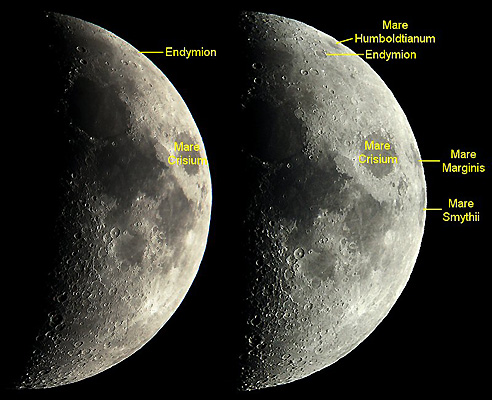January 29, 2015
Nodding Moon
Originally published January 29, 2004
Image Credit: David Haworth |
|
Nodding Moon We glance up and notice the Moon, seeing that its phase and place in the sky are different from yesterday, and we congratulate ourself for our visual astuteness and for being in tune with the cosmos. But is that the only way the Moon changes? This lunar pair by David Haworth graphically illustrates that the answer is No! The Moon librates, or nods to the left or right, up or down, so we actually can glimpse 59% of its surface area. Today's LPOD shows libration in longitude, which occurs because the Moon's rotation about its polar axis is constant, but its elliptical orbit causes it to speed up and slow down at different times so the rotation lags or leads the orbital motion. This pair shows how Crisium is more foreshortened and bunched up close to the limb when libration in longitude is poor (5 July 2003; libration in longitude, l, is -4.5 degrees), but is more circular when libration is quite good (29 Dec 2003; l = +7.0 degrees). Notice that some limb maria such as Humboldtianum, Marginis and Smythii may even be invisible when librations are not favorable. If you want to map the extreme limb regions check the librations, but make sure the side tilted Earthward is actually visible. Perversely, sometimes the best librations occur when the limb area of interest is in shadow! Technical Details: Related Links: Yesterday's LPOD: Outrageous Lunar Colors Tomorrow's LPOD: Lake of Death |
Author & Editor: |
COMMENTS?
Register, Log in, and join in the comments.




